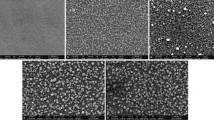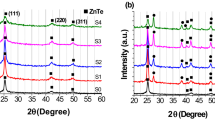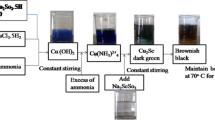Abstract
CuO films with Zr do** were successfully fabricated on substrates of soda-lime glass (SLG) using a spin-coating method at various do** concentrations. X-ray diffraction (XRD) patterns for pure and Zr-doped CuO thin films indicated that all thin CuO films have a monoclinic polycrystalline nature, with two maximum peaks (−111) and (111). The dislocation density values of the (−111) and (111) planes are increased from 13.4 × 1014 to 34.9 × 1014 m−2 and from 26 × 1014 to 42.7 × 1014 m−2, respectively, owing to the expansion of structural parameters with Zr dopant content. Scanning electron microscopy (SEM) indicated nanostructure particles uniformly distributed on all thin-film surfaces without any agglomerated nanostructure particles. The thickness of CuO films in conjunction with Zr do** is approximately 460 nm. The EDX spectrum of pure CuO in thin film contains Cu and O elements; 1%, 2%, and 3% Zr-doped CuO thin films contain Zr, Cu, and O elements, as expected. Atomic force microscopy (AFM) figures indicate that the surface topologies of thin films are uniformly distributed. Ultraviolet–visible spectroscopy (UV–Vis) measurements of the thin films revealed that the transmittance increased from 25% to 45% in the visible range with increasing Zr concentration at room temperature. The energy band gap increased from 1.67 to 2.03 eV with increasing Zr concentration. At room temperature, a Hall effect system was used to investigate the electrical parameters, including carrier concentration, resistivity, conductivity type, and hole mobility of the CuO films with Zr do**. Conductivity type conversion was observed with 2% and 3% Zr-doped CuO, and confirmed by capacity–voltage \((C-V\)) measurements. The charge-carrier concentration of the samples ranged from 1.08 × 1016 to 5.06 × 1018 cm−3 with Zr do**. Thus, the optical and electrical properties of CuO thin film such as the band gap energy, transmittance, and carrier mobility can be modified.
Graphical Abstract









Similar content being viewed by others
References
I. Singh and R.K. Bedi, Studies and Correlation Among the Structural, Electrical and Gas Response Properties of Aerosol Spray Deposited Self Assembled Nanocrystalline CuO. Appl. Surf. Sci. 257, 7592 (2011).
L. Zheng and X. Liu, Solution-Phase Synthesis of CuO Hierarchical Nanosheets at Near-Neutral pH and Near-Room Temperature. Mater. Lett. 61, 2222 (2007).
S.C. Ray, Preparation of Copper Oxide Thin Film by the sol–gel-Like Dip Technique and Study of Their Structural and Optical Properties. Sol. Energy Mater. Sol. Cells. 68, 307 (2001).
J. Ghijsen, L.H. Tjeng, J. van Elp, H. Eskes, J. Westerink, G.A. Sawatzky, and M.T. Czyzyk, Electronic Structure of Cu2O and CuO. Phys. Rev. B. 38, 11322 (1988).
L.O. Grondahl, Copper-Cuprous-Oxide Rectifier and Photoelectric Cell. Rev. Mod. Phys. 5, 141 (1933).
H.C. Lu, C.L. Chu, C.Y. Lai, and Y.H. Wang, Property Variations of Direct-Current Reactive Magnetron Sputtered Copper Oxide Thin Films Deposited at Different Oxygen Partial Pressures. Thin Solid Films 517, 4408 (2009).
C. Zuo and L. Ding, Solution-Processed Cu2O and CuO as Hole Transport Materials for Efficient Perovskite Solar Cells. Small 11, 5528 (2015).
H. Wang, P. Qinmin, Z. Jianwei, Y. Ge**, and Z. Pengjian, Fabrication of CuO Film with Network-like Architectures Through Solution-Immersion and Their Application in Lithium Ion Batteries. J. Power Sources. 167, 206 (2007).
B.S. Kang, S.E. Ahn, M.J. Lee, G. Stefanovich, K.H. Kim, W.X. **anyu, C.B. Lee, Y. Park, I.G. Baek, and B.H. Park, High-Current-Density CuOx/InZnOx Thin-Film Diodes for Cross-Point Memory Applications. Adv. Mater. 20, 3066 (2008).
T. Ishihara, M. Higuchi, T. Takagi, M. Ito, H. Nishiguchi, and Y. Takita, Preparation of CuO Thin Films on Porous BaTiO3 by Self-Assembled Multibilayer Film Formation and Application as a CO2 Sensor. J. Mater. Chem. 8, 2037 (1998).
N.D. Hoa, N.V. Quy, H. Jung, D. Kim, H. Kim, and S.K. Hong, Synthesis of Porous CuO Nanowires and its Application to Hydrogen Detection. Sens. Actuat B 146, 266 (2010).
D.P. Dubal, D.S. Dhawale, R.R. Salunkhe, V.S. Jamdade, and C.D. Lokhande, Fabrication of Copper Oxide Multilayer Nanosheets for Supercapacitor Application. J. Alloys Compd. 492, 26 (2010).
M. Al-Kuhaili, Characterization of Copper Oxide Thin Films Deposited by the Thermal Evaporation of Cuprous Oxide (Cu2O). Vacuum 82, 623 (2008).
S.H. Wee, P.S. Huang, J.K. Lee, and A. Goyal, Heteroepitaxial Cu2O thin film solar cell on metallic substrates. Sci. Rep. 5, 1 (2015).
V. Figueiredo, E. Elangovan, G. Gonçalves, P. Barquinha, L. Pereira, N. Franco, E. Alves, R. Martins, and E. Fortunato, Effect of Post-Annealing on the Properties of Copper Oxide Thin Films Obtained from the Oxidation of Evaporated Metallic Copper. Appl Surf Sci 254, 3949 (2008).
Y. Gülen, F. Bayansal, B. Şahin, H.A. Çetinkara, and H.S. Güder, Fabrication and Characterization of Mn-Doped CuO Thin Films by the SILAR Method. Ceram. Int. 39, 6475 (2013).
C.Y. Chiang, Y. Shin, and S. Ehrman, Li Doped CuO Film Electrodes for Photoelectrochemical Cells. J. Electrochem. Soc. 159, 227 (2011).
J.S. Shaikh, R.C. Pawar, R.S. Devan, Y.R. Ma, P.P. Salvi, S.S. Kolekar, and P.S. Patil, Synthesis and Characterization of Ru Doped CuO Thin Films for Supercapacitor Based on Bronsted Acidic Ionic Liquid. Electrochim Acta. 56, 2127 (2011).
J. Huang, H. Wu, D. Cao, and G. Wang, Influence of Ag Doped CuO Nanosheet Arrays on Electrochemical Behaviors for Supercapacitors. Electrochim Acta. 75, 212 (2012).
J. Morales, L. Sánchez, F. Martín, J.R. Ramos-Barrado, and M. Sánchez, Nanostructured CuO Thin Film Electrodes Prepared by Spray Pyrolysis: A Simple Method for Enhancing the Electrochemical Performance of CuO in Lithium Cells. Electrochim Acta. 49, 4589 (2004).
H.Y. Bae and G.M. Choi, Electrical and Reducing Gas Sensing Properties of ZnO and ZnO–CuO Thin Films Fabricated by Spin Coating Method. Sens. Actuators. B. 55, 47 (1999).
K. Santra, C.K. Sarkar, M.K. Mukherjee, and B. Ghosh, Copper Oxide Thin Films Grown by Plasma Evaporation Method. Thin Solid Films 213, 226 (1992).
S. Sohrabnezhad, M.M. Moghaddam, and T. Salavatiyan, Synthesis and Characterization of CuO–Montmorillonite Nanocomposite by Thermal Decomposition Method and Antibacterial Activity of Nanocomposite. Spectrochim. Acta, Part A. 125, 73 (2014).
T. Serin, Ş Horzum, and Y. Celik, Annealing Effects on the Properties of Copper Oxide Thin Films Prepared by Chemical Deposition. Semicond. Sci. Technol. 20, 398 (2005).
D.P. Joseph, C. Venkateswaran, S. Sambasivam, and B.C. Choi, Effect of Fe Alloying on the Structural, Optical, Electrical and Magnetic Properties of Spray-Deposited CuO Thin Films. J. Korean Phys. Soc. 61, 449 (2012).
Y. Wang, T. Jiang, D. Meng, D. Wang, and M. Yu, Synthesis and Enhanced Photocatalytic Property of Feather-Like Cd-Doped CuO Nanostructures by Hydrothermal Method. Appl. Surf. Sci. 355, 196 (2015).
J. Tamaki, K. Shimanoe, Y. Yamada, Y. Yamamoto, N. Miura, and N. Yamazoe, Dilute Hydrogen Sulfide Sensing Properties of CuO–SnO2 Thin Film Prepared by Low-Pressure Evaporation Method. Sens. Actuat B 49, 121 (1998).
J. Morales, L. Sánchez, F. Martín, J.R. Ramos-Barrado, and M. Sánchez, Use of Low-temperature Nanostructured CuO Thin Films Deposited by Spray-Pyrolysis in Lithium Cells. Thin Solid Films 474, 133 (2005).
L. Obulapathi, A.G. Kumar, T.S. Sarmas, and T.S. Rao, Room Temperature Studies of Cr Doped Copper Oxide Thin Films by Reactive Dc Magnetron Sputtering. Int J Nanotechnol Appl. 4, 29 (2014).
C. Tamuly, I. Saikia, M. Hazarika, and M.R. Das, Reduction of Aromatic Nitro Compounds Catalyzed by Biogenic CuO Nanoparticles. RSC Adv. 4, 53229 (2014).
D. Gopalakrishna, K. Vijayalakshmi, and C. Ravidhas, Effect of Annealing on the Properties of Nanostructured CuO Thin Films for Enhanced Ethanol Sensitivity. Ceram. Int. 39, 7685 (2013).
B.D. Cullity, Elements of X-ray Diffraction, 1st ed., (Boston: Addison-Wesley Publishing, 1956).
H. Mersian, M. Alizadeh, and N. Hadi, Synthesis of Zirconium Doped Copper Oxide (CuO) Nanoparticles by the Pechini Route and Investigation of their Structural and Antibacterial Properties. Ceram. Int. 44, 20399 (2018).
M. Barsoum, Fundamentals of Ceramics, 2nd ed., (Boca Raton: CRC Press, 2019).
K. Mageshwari and R. Sathyamoorthy, Physical Properties of Nanocrystalline CuO Thin Films Prepared by the SILAR Method. Mater. Sci. Semicond. Process. 16, 337 (2013).
C. Gao, H. Shen, L. Sun, and Z. Shen, Chemical Bath Deposition of Bi2S3 Films by a Novel Deposition System. Appl. Surf. Sci. 257, 7529 (2011).
S.M. Jabbar, Synthesis of CuO Nano Structure Via Sol-gel and Precipitation Chemical Methods. Al-Khawarizmi Eng. J. 12, 126 (2016).
S. Anandan and S. Yang, Emergent Methods to Synthesize and Characterize Semiconductor CuO Nanoparticles with Various Morphologies–An Overview. J. Exp. Nanosci. 2, 23 (2007).
S. Manjunatha, R.H. Krishna, T. Thomas, B.S. Panigrahi, and M.S. Dharmaprakash, Moss-Burstein Effect in Stable, Cubic ZrO2: Eu+3 Nanophosphors Derived from Rapid Microwave-Assisted Solution-Combustion Technique. Mater. Res. Bull. 98, 139 (2018).
C. Muiva, T. Sathiaraj, and K. Maabong, Effect of Do** Concentration on the Properties of Aluminium Doped Zinc Oxide Thin Films Prepared by Spray Pyrolysis for Transparent Electrode Applications. Ceram. Int. 37, 555 (2011).
J. Tauc, Amorphous and Liquid Semiconductors, 1st ed., (Berlin: Springer, 2012).
M. Balog, M. Schieber, M. Michman, and S. Patai, The Chemical Vapour Deposition and Characterization of ZrO2 Films from Organometallic Compounds. Thin Solid Films 47, 109 (1977).
S. Jena, R.B. Tokas, S. Thakur, and N.K. Sahoo, Optical Properties of Electron Beam Evaporated ZrO2: 10% SiO2 thin films: Dependence on Structure. Indian J. Phys. 90, 951 (2016).
G.Y. Naser, W.N. Raja, A.S. Faris, Z.J. Rahem, M.A. Salih, and A.H. Ahmed, Some Optical Properties of CdO Thin Films. Energy Procedia. 36, 42 (2013).
M. Wang, J. Liu, J. Hu, and F. Liu, O2–CO2 Mixed Gas Production Using a Zr-Doped Cu-Based Oxygen Carrier. Ind. Eng. Chem. Res. 54, 9805 (2015).
H. **hong, F. Gao, Y. **ang, H. Wu, X. Zheng, J. Jiang, J. Li, H. Yang, and S. Liu, Influence of Oxygen Pressure on the Structural and Electrical Properties of CuO Thin Films Prepared by Pulsed Laser Deposition. Mater. Lett. 176, 282 (2016).
A. Ogwu, T. Darma, and E. Bouquerel, Electrical Resistivity of Copper Oxide Thin Films Prepared by Reactive Magnetron Sputtering. J. Achiev. Mater. Manuf. Eng. 24, 172 (2007).
E.K. Shokr, M.M. Wakkad, H.A. Abd El-Ghanny, and H.M. Ali, Sb-Do** Effects on Optical and Electrical Parameters of SnO2 Films. J. Phys. Chem. Solids. 61, 75 (2000).
S. Cho, Optical and Electrical Properties of CuO Thin Films Deposited at Several Growth Temperatures by Reactive RF Magnetron Sputtering. Met. Mater. Int. 19, 1327 (2013).
D.M. Jundale, P.B. Joshi, S. Sen, and V.B. Patil, Nanocrystalline CuO Thin Films: Synthesis, Microstructural and Optoelectronic properTies. J. Mater. Sci.: Mater. Electron. 23, 1492 (2012).
Y. Shen, M. Guo, X. **a, and G. Shao, Role of Materials Chemistry on the electrical/electronic properties of CuO thin films. Acta Mater. 85, 122 (2015).
S.M. Sze, Y. Li, and K.K. Ng, Physics of Semiconductor Devices, 4th ed., (Hoboken: Wiley, 2021).
D.A. Neamen, Semiconductor Physics and Devices Basic Principles, 3rd ed., (New York: McGraw-hill, 2003).
H.Z. Asl and S.M. Rozati, Spray Deposition of n-Type Cobalt-Doped CuO Thin Films: Influence of Cobalt Do** on Structural, Morphological, Electrical and Optical Properties. J. Electron. Mater. 49, 1534 (2020).
S. Baturay, I. Candan, and C. Ozaydın, Structural, Optical and Electrical Characterizations of Cr-Doped CuO Thin Films. J. Mater. Sci. Mater. Electron. 33, 7275 (2022).
Funding
This study was funded by the Scientific Research Projects Coordination Unit of Dicle University for the support with the number FEN.18.007.
Author information
Authors and Affiliations
Corresponding author
Ethics declarations
Conflict of interest
The authors declare that they have no conflict of interest.
Additional information
Publisher's Note
Springer Nature remains neutral with regard to jurisdictional claims in published maps and institutional affiliations.
Supplementary Information
Below is the link to the electronic supplementary material.
Rights and permissions
About this article
Cite this article
Baturay, Ş. Conversion from p- to n-Type Conductivity in CuO Thin Films Through Zr Do**. J. Electron. Mater. 51, 5644–5654 (2022). https://doi.org/10.1007/s11664-022-09836-9
Received:
Accepted:
Published:
Issue Date:
DOI: https://doi.org/10.1007/s11664-022-09836-9




